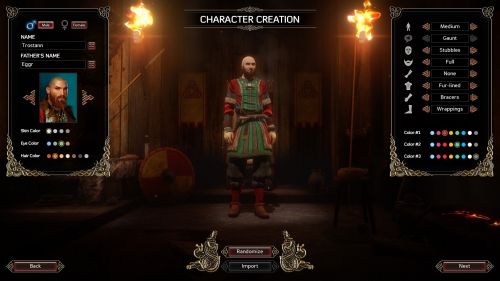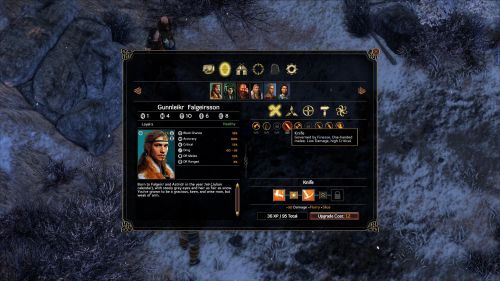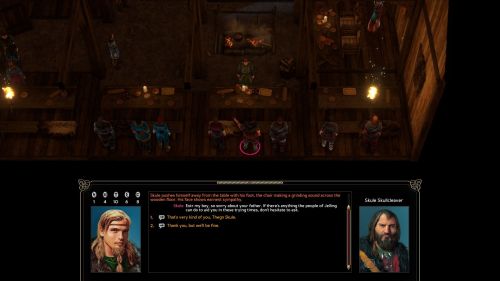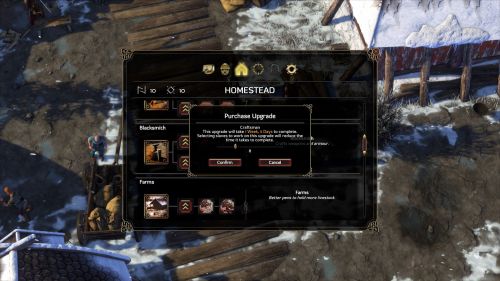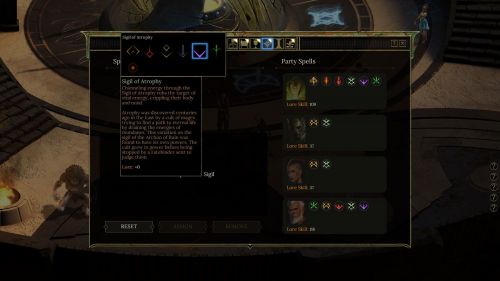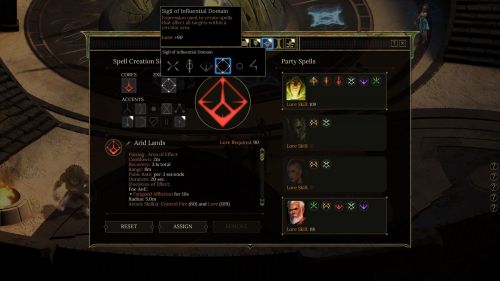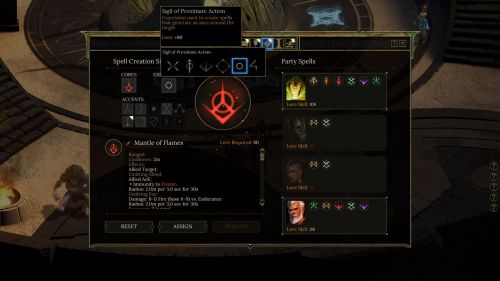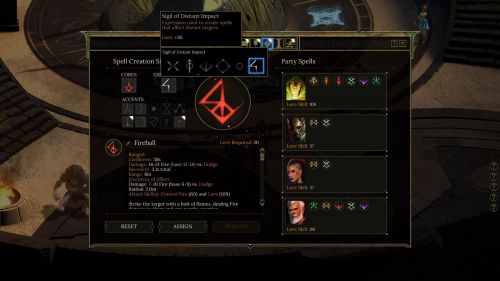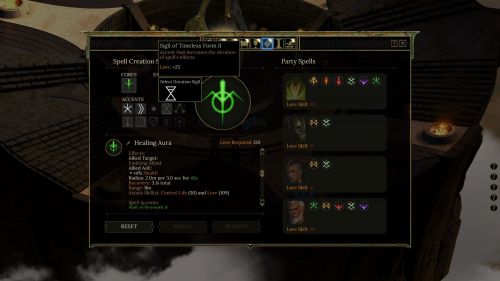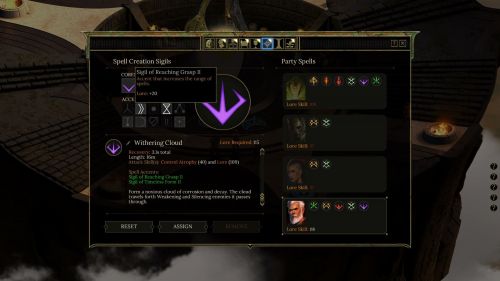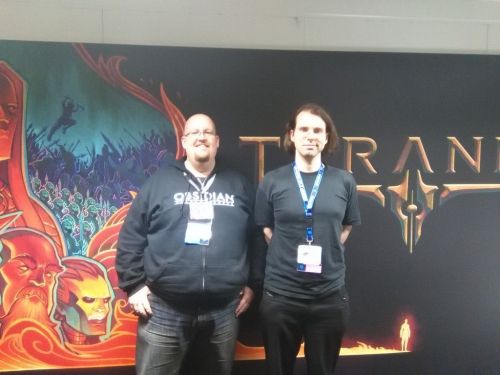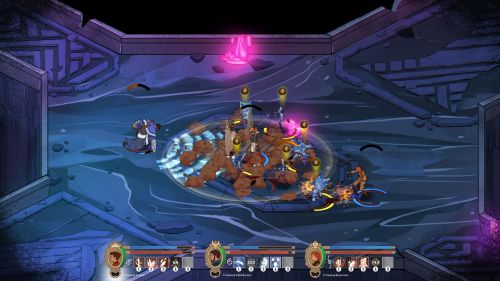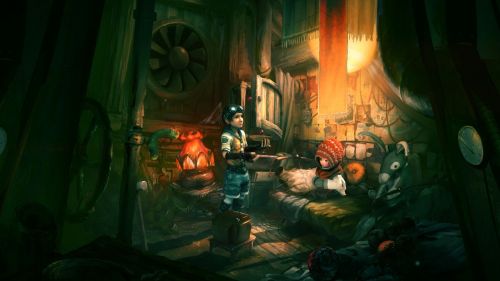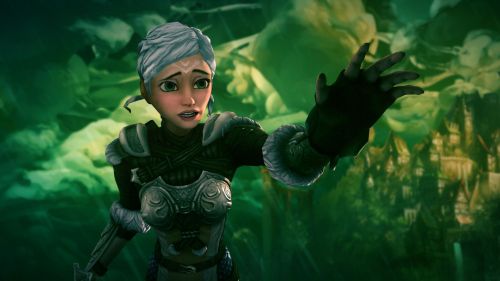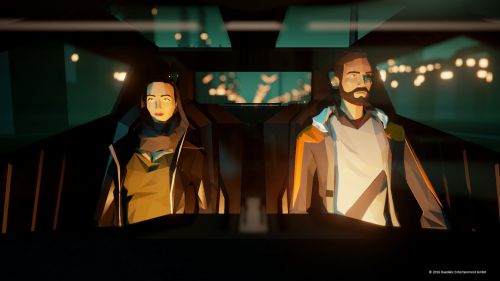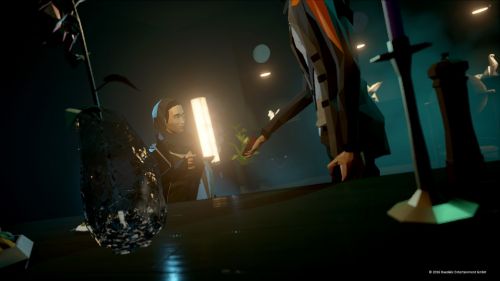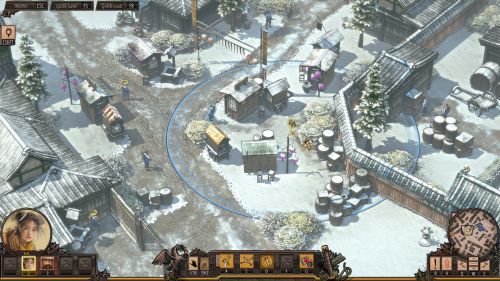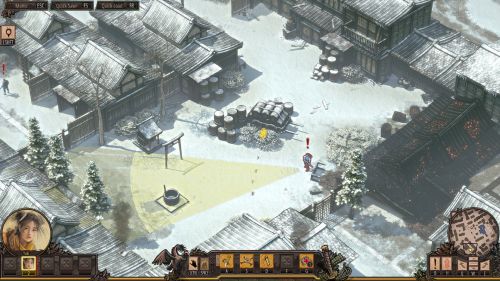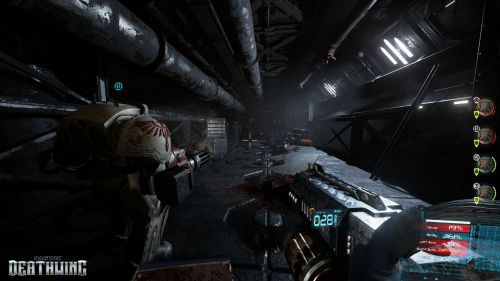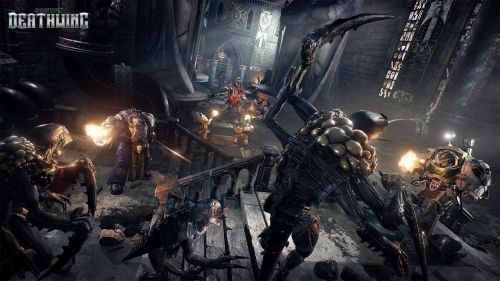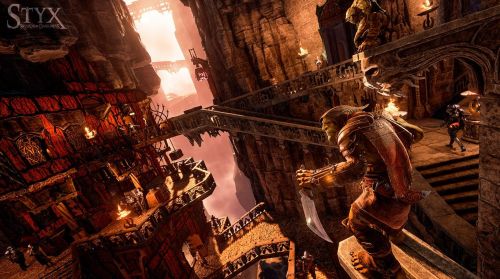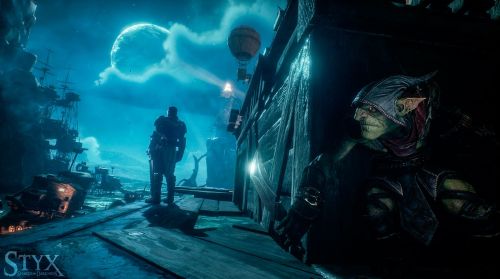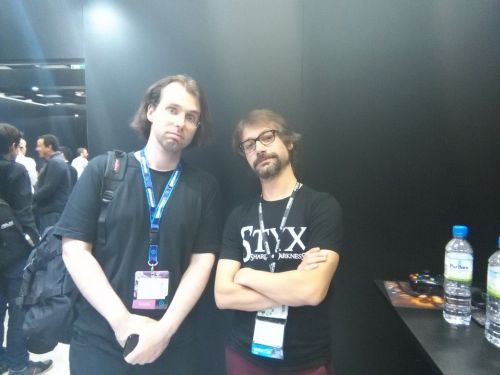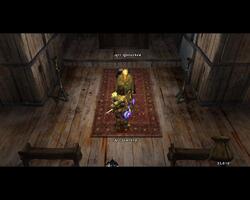RPG Codex Report: Gamescom 2016 - Expeditions: Viking, Tyranny, Space Hulk: Deathwing, Styx and more
RPG Codex Report: Gamescom 2016 - Expeditions: Viking, Tyranny, Space Hulk: Deathwing, Styx and more
Editorial - posted by Bubbles on Thu 22 September 2016, 16:02:42
Tags: Brian Heins; Cyanide Studio; Daedalic Entertainment; Expeditions: Viking; Focus Entertainment; Gamescom 2016; Logic Artists; Masquerada; Mimimi Productions; Obsidian Entertainment; Shadow Tactics; Silence: The Whispered World 2; Space Hulk: Deathwing; State of Mind; Streum on Studio; Styx: Shards of Darkness; The Long Journey Home; Tyranny; Witching Hour StudiosExpeditions: Viking
After last year's Gamescom, we delivered you a lengthy and detailed report on three of Expeditions: Viking's core features: the main narrative, the travel mechanics, and the camping screen. This year, we once again met up with Alex Mint from Danish studio Logic Artists to discuss character creation and the combat system.
But let's start with the most important bit of news: the devs are planing to launch a closed preview of the game in October of this year, and the Codex will get a chance to prove once again that we have the best and brightest testers and feedback-givers in the industry. The preview build will include the first "10 to 20 hours" of the game, so it should be quite a meaty experience that should allow for a lot of in-depth testing. We don't know how many keys we'll be getting or how they're going to be distributed, but that shouldn't stop you from voicing your interest in the comment section.
Our entire appointment was structured as a hands-on, meaning that I could explore the menus and check out everything Alex was telling me about on the fly. I don't think it's a coincidence that all of our favourite previews this year offered hands-on opportunities; a proper, lengthy hands-on is simply the best way to get a feel for the actual substance of a game, and to figure out whether it's really any good at all.
Character Creation
Thankfully, what I experienced in our 30 minutes with Expeditions: Viking was both fun and complex. Alex started by guiding us to the character creation screen, which cleared up a few misconceptions I had had about the game. In my darkest nightmares, I had imagined that E:V's new classless character system might include some sort of MMO-style ability trees, or some other highly restrictive mechanism that might have made the game easier to balance. Fortunately, the developers have instead opted to offer a more free-form system. From the start, you are given access to a huge array of active and passive skills (by my count, the screens currently list over 50 skills in 5 different groups) and you're allowed to build whichever type of character you like by investing points into each of these skills. You also have five primary stats between which you can distribute points: Strength, Endurance, Finesse, Perception, and Sense. Certain skills have primary stat requirements, so you're encouraged to make some basic specialization decisions right from the start; for example, a character who focusses on ranged combat skills will also want to take some Perception.
Some of the skills only have a single rank, while others can be upgraded further; for example, weapon skills go from rank 0 to rank 5. Each rank of a weapon skill offers a passive bonus, and each uneven rank (i.e. ranks 1, 3, and 5) also unlocks a new unique combat ability. The hands-on already offered 7 different weapon skills: Axes, Bows, Knives, Shields, Two Handed Spears, Swords, and Unarmed Combat. Two others were still hidden, presumably to preserve the mystery.
Apart from the weapon skills, the character can take offensive skills like Dual Wielding, which are not linked to any specific weapon and unlock general combat abilities. There are also camping skills – which Alex skipped, since we had already heard about them last year –, and support skills. The support skills are governed by the Sense stat, which Alex described as "a combination of the Wisdom and Intelligence stats from traditional RPGs." These support skills cover anything from bardic songs to trap detection and movement skills; there's also a Leadership skill that unlocks in-combat buffs as well as extra dialogue options. The fifth and final group of skills are the passive skills, which make their return from Expeditions: Conquistador. Old favourites like Hardened (+10 HP) and Quick Feet (which allows movement inside an enemy's AoO range) are returning among a slew of other options. Most of the passive skills were still hidden in the demo, but there were designated spots for 30 different skills, which is a pretty respectable number. Let's just hope that the devs can figure out how to balance them all.
Since Alex had highlighted Leadership as an important dialogue skill, I made sure to ask him whether it was the only dialogue skill. Thankfully, E:V aims to have a varied system of skill and stats checks that should allow for plenty of reactivity in the game. Alex listed examples like using the Sneak skill to assassinate somebody in dialogue, using Strength to overpower them, or using Sense to convince them. He also mentioned a specific enemy who could be recruited into our party if we managed to beat him in a duel. The developers have also put a few stat checks into the battle maps; for example, if you walk over a patch of ice, you'll have to check your character's Finesse to avoid slipping and falling. All of the dialogue checks will be graded into categories of "Easy", "Medium", and "Hard". Alex didn't specify whether these checks were influenced by randomization (i.e. virtual die rolls) or if they simply required a minimum stat value to succeed; I'm sure the Codex community will want to voice their strong preferences either way.
One important caveat is that we didn't actually get to build a full character from scratch in the demo; we could only choose from about a dozen pre-set builds like "Berserker" or "Bannerman" before hopping into battle. Alex explained that this simplification was necessary for the trade shows; otherwise the character creation would easily take up the entire demo time. I fully believed him. In the final game, it's actually supposed to work the other way around: your character will automatically receive a title and a short description based on which skills you pick for them. If they take axes and dual wielding, the game might identify them as a Berserker, while a character who focusses on the Leadership skill may be called a Bannerman. These titles seem fairly superfluous to me, but some players might find them helpful for defining their character's role in a classless system.
Combat
Before we launched into the combat proper, Alex gave us some context about our upcoming battle. This encounter was taking place in the first part of the game, which was called the "Home Campaign". Our main character had only recently established himself as the new leader of his people, and he now had to complete three basic tasks before he could start a career as a proper Viking raider. He had to gain enough resources to build a ship, he had to gather enough followers to crew the ship, and he had to consolidate his power in the region to make sure that his village would be safe while he was away.
In the demo, we were still far away from completing any of those goals: our struggling village was beset by bandits, and we had to fight them back by any means necessary. After a very short dialogue (the only one in the demo, unfortunately), we were offered two options: join the defenders at the main gate, or help to defend the southern bridge. The two options were highlighted by big quest markers on the local map. I asked Alex if we could turn off quest markers in the final game; he said that the option wasn't available at the moment, but that it might be implemented if enough Codexers complained about it (*hint*).
We finally chose to fight on the bridge, and battle ensued. As soon as I and Jarl saw the map, we decided that this would be a ranged battle; the bridge itself was only two hexes wide and relatively long. Meanwhile, the riverbank on our side offered a good line of fire on the enemy units and provided lots of cover against hostile archers. Cover is especially useful in E:V because the game lets you make more than one move per turn. If you have five movement points and one action available, then you can move two hexes forward, attack, and then move three more hexes before the enemy has a chance to take an action. We didn't see an overwatch mechanic in the demo. I asked Alex if moving before shooting your bow would give you any penalties; no, it didn't. In fact, Alex encouraged us to walk towards our enemies before shooting to gain extra accuracy, and then walk back into cover afterwards. Our archers also had the Signal Arrow ability, which could be used to fire a light source into a medium-sized area on the map; the light made all characters inside that area significantly easier to hit with ranged attacks. And that's not all: simply shooting at an enemy already gave them a special debuff, making them Harried no matter if the arrow hit or missed (the term "harried" was suggested by esteemed Codexer almondblight, so you can direct all of your complaints directly to him). We asked if ranged weapons would deal significantly lower damage than melee weapons; Alex replied that bow damage could be "very, very high" with the right stats. Hm, well then. We proceeded to switch most of our melee fighters to their ranged weapon sets, put two sturdy defenders on the bridge, and utterly dominated the enemy forces.
Of course, I wouldn't expect perfect balance or supercomputer-level enemy AI from a game that's still a fair distance away from release; instead, the most important consideration should be whether the gameplay is currently fun, even when it feels too easy. And so far, E:V seems to be succeeding admirably in that regard. One of the most interesting features of the combat system are the detailed tooltips; when hovering over an enemy, you can see your chance to hit them and the expected damage, as well as their current hit points, their dodge and block chances, their damage reduction, and their current status effects. Fretting over all of this information and figuring out which enemies we should attack from which position was by far the most enjoyable aspect of the combat for me. Was it worth rushing out all the way towards the riverbank with one of our least accurate archers because a successful hit could take out a powerful enemy unit? Should we use Quickshot (which fires two arrows with reduced accuracy and range) to try and take down an enemy quickly, or did we have a better chance if we only fired a single arrow and relied on the next friendly unit to finish the job from a more favourable shooting position? Was it worth repositioning two of our team members to lure more of the enemy archers into our Signal Arrow area? These kinds of considerations are exactly what I play tactical combat games for.
Overall, I'm quite happy with the current state of the combat in Expeditions: Viking; it still seems to need a fair bit of balance and AI work, and many of the active combat abilities still have to be implemented, but even in this early state it already feels genuinely fun and tactical to play. If the developers can establish at least a vague sense of balance between those 50+ skills, and if they can offer as much c&c and reactivity as advertised, then Expeditions: Viking should turn out to be a pretty good game indeed.
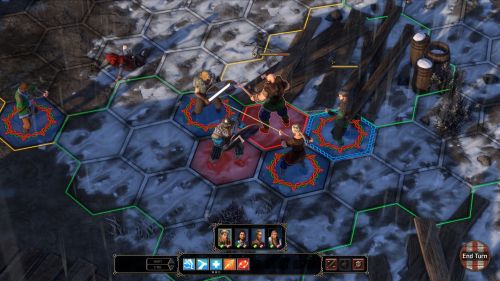
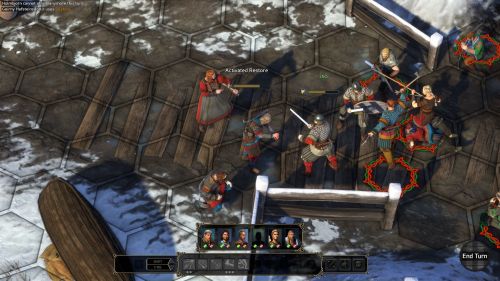
The battles can get pretty busy, but they're turn based, so that's all right. You wouldn't normally pull your archers that far forward though.
Jarl's Impressions
We had a nice session of hands-on gameplay with that one, which was over way too quickly. As Bubbles said, we fought a battle on a bridge and got to use some interesting special abilities of our characters. Overall, the game felt pretty much exactly like Conquistador, only in a different setting, which is a good thing. Conquistador's combat mechanics were solid and the exploration was fun; this promises to be more of the same with some improvements. The most major changes are that you don't choose your entire crew at the character creation screen, and the new classless system.
If you enjoyed Expeditions: Conquistador, this is pretty much a must buy. Conversely, if you didn't like Conquistador at all, this game isn't going to change your mind about the series. This game does what a sequel is supposed to do: it improves upon the original formula without changing it beyond recognition. I, for one, am looking forward to go on expeditions with my Viking bros. At least concerning the combat and the character system, this is everything a sequel should be. We haven't seen any of the overland exploration gameplay during our brief hands-on, but considering how good the rest of the game looks, this element should also be heading in the right direction.
Also, I would like to ask the entire Codex to complain about the quest markers until the devs add the option to turn them off. Thank you.
Tyranny
The RPG Codex is the biggest Tyranny fan site on the net, and we were naturally very eager to get our hands on Obsidian's newest masterpiece. Tyranny is billed as a c&c-heavy party-based isometric game set in a Bronze Age fantasy world where #EvilWon; the player character has a middle-management role in the new evil empire, and you'll be given plenty of options to decide just how evil you want to be. The game will feature lots of streamlined RTwP combat against level scaling enemies, an Oblivion-style progression-by-use skill system combined with MMO-style talent trees, and a certain amount of design input by Tim Cain. In other words, it has all the right ingredients to become a Codex favourite.
To be perfectly honest, nearly every bit of news we've heard about Tyranny so far has resulted in rampant mockery on the Codex forums. Personally, I've been greatly concerned about the quality of the game's writing, about the amount of actual branching that would be offered, about the consistency of the game's setting (Sure, #EvilWon, but what IS evil in this setting? Why do the “Bronze Age” people have punk haircuts and talk like modern Californians?), and about the feasibility of a combat system that's basically a cross between the systems from Aarklash: Legacy and Pillars of Eternity. Would the Tyranny hands-on be able to dispel my doubts?
Unfortunately, our session didn't feature any dialogue or c&c at all; instead, we spent a few minutes discussing the new spellcrafting mechanics before launching into a short dungeon delve where we got to experience various puzzles, fought lots and lots of mobs, and had a big boss battle. Our host was the game's lead designer Brian Heins, who was surprisingly gracious and good-humoured considering we were meeting him at 5:30 PM as the last group on the final day of presentations. Many of the other presenters we had met around that time were already showing signs of severe mental strain, so it was impressive to see that Brian was still holding up so well. Sadly, we weren't able to properly grill Mr. Heins on the details of his game, since he still had an important Twitch interview to attend right after our session. The big questions like “Who exactly is your target audience for this game?” will have to wait for another time.
Spellcrafting
Brian began our hands-on by guiding us through the new spellcrafting interface. Spellcrafting is probably the most complex system we have seen in Tyranny thus far; basically, you unlock new crafting options by collecting special “sigils” in the world, and then you combine these sigils to create a custom spell. First, you choose a Core sigil, which determines which type of spell you're making; for example, the Sigil of Force will give you a crowd control spell with a knockdown effect. Then, you pick an Expression sigil to determine the spell's shape and range; you can have a ranged AoE (“Sigil of Influential Domain”), an aura (“Sigil of Proximate Action”), a cone, a projectile, etc. etc. Finally, you can add a number of Accents that improve your spell in general ways, for example by extending its range or boosting its effects.
The more boosters and effects you slap together, the higher the Lore requirement of the spell will be; Lore is basically the general spellcasting skill in the Tyranny setting, and it's also used in conversations. If your character has 135 Lore, you can craft a fairly powerful spell for them; then, once they gain another five points, you can add another Accent to make the spell even stronger. Conversely, a character with only 80 Lore will have to modify the spell, stripping away a couple of extra effects and maybe even changing its shape from a circular AoE to a cone before he'll be able to cast it. Some spells also have secondary skill requirements in addition to the Lore check; for example, a fireball might require proficiency in Control Fire before it can be cast. Overall, Spellcrafting seems like a pretty cool system; if the devs can offer a broad selection of sigils and give players enough incentive to keep switching things around, then it should be a fun addition to the gameplay. The game's PR people seem to agree, as the press kit they sent us consists entirely of screenshots of the spellcrafting interface. Feel free to click through the pictures if you're interested.
Dungeon Crawling and the Combat System
Brian crafted a few spells for us, and then he let us loose to do a bit of dungeon crawling in one of the game's two big “Oldwall dungeons.” The level vaguely looked like one of the Engwithan ruins in PoE, only a bit darker and with some neat graphical effects. The developers have inserted a bunch of moving elements into the scenery; mechanical staircases now rise out of the floor block by block, while bridges extend and retract on the flip of a switch. The backgrounds feel livelier compared to PoE, and that's not a bad thing.
Our actual dungeon crawling experience was fairly straightforward: we explored a small chunk of the dungeon until we found an empty socket for a runestone in one of the walls. Then we had to explore further to find the runestone (which would either be guarded by monsters or cause a monster closet to open when you picked it up), come back to the socket, and insert it to open a path to the next area. After that, another empty socket, and another stone. Rinse, repeat. The most “complex” puzzle occurred when we found one of the stones in a small room that was only accessible through a bridge. Removing the stone from its pedestal caused the bridge to retract and a bunch of monsters to spawn; the only way to leave was to take a brick from a nearby pile of rubble and put it into the bowl to extend the bridge again. I wouldn't say that the dungeon crawl gave us a very satisfying puzzle experience or that it really offered any sort of intellectual stimulation, but I can accept that this was merely a press preview. Maybe the final game will offer something a bit more interesting.
And now… to the combat. Tyranny's combat system is a bit difficult to describe; on the one hand, it shows clear signs of casualization compared to PoE, like the small party size (4 characters instead of 6), the total removal of friendly fire from the game, the removal of the health system, a drastic shift away from per-rest and per-encounter abilities in favour of cooldown-driven combat, the introduction of powerful “awesome button” combo abilities, a focus on strong companion AI, an MMO-style aggro system with taunting abilities (but still with PoE's engagement system on top of that), and a noticeably clunkier UI that looks prettier, but requires more clicks to access basic info. (For example, if you want to know an enemy's fire resistance, you need to right click on them, move the mouse over to a newly opened window, find the “fire” icon among a clump of other big shiny icons, and hover over that to get a tooltip. In PoE, you just had to hover your mouse over a dude and look at the DR line in the top left of the screen.) On the other hand, the game doesn't actually feel very “casual” to play. Right now, it's best described as a bit of a confusing mess.
When I saw the first footage of Tyranny's combat, my main concern was about the outsized importance of cooldown management; unfortunately, the hands-on confirmed my suspicions. We were controlling four party members; each of them had between 3 and 6 cooldown-based abilities in addition to the per-encounter Awesome Combos and various potions. The cooldown times covered a wide range; the shortest cooldowns lasted around 15 seconds, while the longest one I saw was two minutes. You can use spellcrafting and equip special items to add further abilities on demand; the only limit we saw in the demo was the length of each character's hotbar, which is limited to ten slots. But ten active abilities per character, most of them on cooldowns, will still amount to a lot of micromanagement. The UI doesn't let you see all of your characters' cooldowns at the same time, so the only way to “actively” play the game is to constantly pause it, check each character's cooldowns, use the best abilities that are currently off cooldown, try to memorize when each character's next cooldown expires, unpause for a few seconds, and then pause again until you can use the next ability on at least one character. Or you can rely on the party AI to do that stuff for you, with the caveat that they might waste an ability with a two minute cooldown on a totally irrelevant target.
It seems to me that Tyranny is meant to be played with a fully active AI; otherwise the amount of micromanagement required would seem absurdly high. But who wants to play a game where the AI does most of the work, firing off abilities while you admire the light show? Is that something that appeals to a large segment of the gaming population? Personally, I find it a bit dull. Dragon Age: Origins was another cooldown-heavy game, but Bioware at least offered us access to a freely programmable AI; this way you could let the computer do a big chunk of the "use x whenever x is off cooldown"-type busywork and still feel like you were in control over your companions' actions. On the other hand, Aarklash: Legacy only had minimal party AI, but it limited the amount of required micromanagement by capping the amount of active abilities at 4 per character. It's also worth noting that Aarklash only offered a small pool of abilities to choose from, and each of them was represented by a big, distinctive looking icon that could be recognized at a glance. By contrast, Tyranny's icons are smaller, more intricate, more numerous, and more closely cramped together; it's harder to distinguish them at a glance. Taken together, all of these issues make the combat feel messier and clunkier than it needs to be.
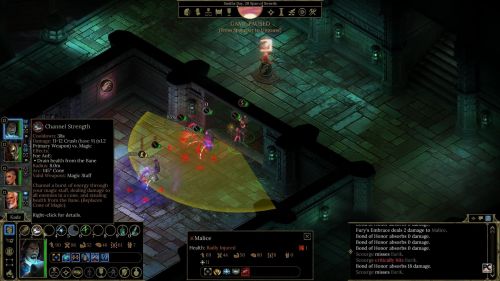
This "screenshot" is actually captured from a PCGamesN video. That's not really an ideal source, but at least it shows you our demo dungeon and the current battle UI.
Brian also introduced us to the tactical elements of Tyranny's gameplay. The game still has a respectable array of DoTs, buffs and debuffs, though the available selection to be a bit more limited and streamlined; I got the impression that the really powerful stuff was reserved for the per-encounter companion combos, at least for the purposes of the hands-on demo. On top of that, Brian introduced us to the new creature resistance system. The creatures who populated the dungeon were part of what the Tyranny writers have consciously chosen to call “The Magebane”: “Wisps”, “Scourge,” “Malice”, and “Havoc” – or, as I ended up calling them, “Red swirl, White swirl, Blue swirl, and Boss swirl”. Red swirls had 100% fire resistance, but took 100% extra cold damage. The other swirls followed the same pattern: 100% resistance to X, 100% extra damage from Y. Only the Boss swirl was different: he took 15% increased damage from all elements. Brian had crafted various elemental spells for us, and he encouraged us to use our fire spell on the enemies that took 100% extra damage from fire, while avoiding to use it against enemies with 100% resistance to fire. The companion AI was capable of recognizing these resistances and making the proper spellcasting decisions by itself, which is – credit where credit is due – a big step up from PoE. However, coming fresh off the presentation for D:OS 2, these kinds of “tactics” seemed a little meagre to me.
Things got a little more complicated in the final boss fight, which lasted several minutes. It was basically a miniature raid encounter with different phases; the boss behaved differently in each phase and also gained a few special status effects over time. The combat arena featured a bunch of “red Bane traps”, which constantly spawned new adds into the combat arena; these adds could also heal the boss if you didn't kill them quickly enough. The AI wasn't quite good enough to handle that encounter on its own, so we actually had to invest some effort into this battle; as a consequence, it was easily the highlight of the demo. The overall experience reminded me quite strongly of the boss battles in Aarklash: Legacy – with the caveat that Aarklash had friendly fire and only four cooldown abilities per character, which rather seemed like a superior system.
Ultimately, I would describe Tyranny's combat and dungeon crawling gameplay as “not impressive”. Between the multitude of cooldowns, the clunkier UI, the removal of friendly fire, and the dominant companion AI, the battles managed to feel both busier and more opaque than they were in PoE. Ideally, the game would have to undergo a major UI improvement, making it easy to tell at a glance which abilities are on cooldown among all party members, and how long these cooldowns are; that way, it might be feasible to completely disable the companion AI without being suffocated by cooldown management. I'd also prefer it if more of the enemies' stats were directly represented as text instead of being hidden in the tooltips of icons, especially important stuff like elemental resistances. However, it should be noted that Tyranny has been mostly pitched as a “story game” so far; consequently, we probably shouldn't put too much emphasis on the quality of its combat systems. I really hope that we'll see a video that focusses on skill checks and c&c soon; those elements of the game might still be worthy of greater enthusiasm.
Finally, there are a few random titbits of info we snapped up during the hands-on. You can still increase the in-game speed out of combat just like in PoE, which will be very useful for backtracking through those long dungeon corridors. Character defences do not scale directly with level like in PoE, but are only improved through stats, skills and items; however, this does not apply to enemies, whose defences scale directly with their level. The party members are currently spamming fully voiced taunts during combat; for instance, our resident edgelady Verse shouted lines like "Bleed out, you little shit! Bleed out, you little shit! I'll tear your skull out by your ass!" at least once per battle. I ended up finding that slightly annoying; I hope we'll be able to turn these lines off completely. I also noticed that the world map was littered with dozens of small coin icons, and probed Brian a bit about that subject; he eventually replied that these were “locations where you can meet characters”. Hm. I'm sure they'll tell us more when they're ready. Tyranny is supposed to be released some time this year.
Jarl's Impressions
Hey, it's Pillars of Eternity but different!
The most interesting thing about this game was the spell system. Crafting custom spells is always a welcome addition to any RPG, and even though it doesn't fully reach the exploitableness of Morrowind's spellcrafting system (then again, what does?), it looks to be quite fun to experiment with different effects and power levels. You can pick the damage type/element you want to have in your spell, the type of spell you want (AoE, single target, projectile, fan, etc.), and some additional effects and this way forge custom spells that give you a little more flexibility than a fixed spell selection would. You really like that fire spell that lets you shoot out a fan of flames from your hands, but you want it with lightning instead? Yeah, you can do that. You want to use iceballs instead of fireballs? Sure, why not. It adds a nice level of customization to spellcasting which has a lot of potential. I just hope it doesn't mean that there are fewer cool unique spells and every spellcaster just flings out generic combinations of elemental magic.
The combat itself seemed almost like a straight Eternity clone to me, but then I only watched while Bubbles played it hands-on so my experience with it is less direct than his. I don't share his concern about the huge amount of cooldown abilities you have to manage, as I like having more options - yes, I even enjoy being so swamped with options I lose my track over them. Now, I don't like companion combat AI (which has always been a shit feature to me, I want to control my dudes myself, not have them make bad tactical decisions that end up disadvantaging me), but I don't think it's entirely necessary to manage all the cooldown abilities at all times. It is nice to have so many available during a hard fight, but most fights seem easy enough to not require you to pay constant attention to every single ability you have. Sure, you can do that, but you don't have to. It's nice to have such a multitude of options during difficult encounters. During most normal encounters you can just ignore them.
Overall, the basic gameplay systems seemed all right, and what's going to make or break the game is the actual level design. To me, Baldur's Gate 2 is infinitely better than Baldur's Gate 1 due to having more interesting locations, better dungeons and more exciting encounters. As long as the systems are solid (which Tyranny's seem to be), it's fine. The level design is what actually carries the game. And to judge that, I'd need to spend some more time inside a dungeon, freely exploring it without the guidance of a dev.
But from what I've seen, I can say with some certainty: if you liked Eternity, you will like this. If you hated Eternity, you will hate this. The games are mechanically similar enough that this is pretty much a certainty.
Masquerada: Songs and Shadows
If you've read the Tyranny report and thought "I wonder what a greatly streamlined and casualized version of this game would look like!”, then Masquerada might just be the title for you. The new isometric RPG from Singaporean developer Witching Hour Studios is billed as a story-focused game with “pause for tactics” combat, featuring pretty looking graphics, a world-famous voice cast that includes Felicia Day and Ashley Burch, a strictly linear 12-hour storyline set in a fantasy city based on Renaissance Venice, minimal exploration, limited character progression, no combat log, and no inventory system whatsoever; it also claims to be inspired by Baldur's Gate. On the strength of these features, the devs managed to raise £60k on Kickstarter earlier this year.
We got a chance to play Masquerada's public Steam demo in the hands-on booth; I would characterize the experience as “2 minutes of boring dialogues, 18 minutes of whacking through trash mobs”. The game lets you take up to three party members with up to five cooldown-based active abilities each. This relatively small scope allows the designers to show all of the party's abilities and their cooldown timers on the screen at the same time, which at least makes the combat look a little more coherent than it does in Tyranny. Unfortunately, Masquerada does not give you full control over your own party; you can only control a single character at a time, while the others are controlled by the overbearing party AI. Worse yet, the enemies we faced in the demo had so many hit points and so little offensive power that the battles offered very little challenge or entertainment. The most tactically complex enemy was a miniboss who occasionally performed a telegraphed AoE attack; you had to walk away from him while he was attacking, and then return when he was finished.
Meanwhile, the little pieces we saw of the storyline were clichéd and forgettable, and the dialogues were totally non-interactive as well. The game's producer Brian Kwek explained that their budget was too small to offer a “Pillars of Eternity-style experience with branching dialogues” and so forth. Instead, they were content to deliver a linear, cinematic story with full voice acting. The combination of “small budget” and “full voice acting” might explain why the dialogue sequences in the demo were padded out with so many trash mob encounters.
Thankfully, our time with Masquerada wasn't a total loss. Notorious community member Roguey had heard that another Codexer was connected to the project, and he wanted us to ask the devs about the details of their connection.
Bubbles: We were curious why your Kickstarter campaign included a giveaway of a book by Benji… Benjun... Sid... [The name is “Benjanun Sriduangkaew”. I will not forget again.]
Brian: Oh yeah...
Bubbles … why was it chosen?
Brian: To be perfectly honest, it was because Cassandra liked it… er, hey, Cassandra!
[He calls over Cassandra Khaw, a published novelist who works for the game's publisher under the job title of “Businesscat” and reviews video games at Eurogamer and Ars Technica]
Cassandra: You're asking about Scale-Bright? So it's created by a Thai woman living in Hong Kong; she's very interested in the mythology of her homeland and Asian cultures in general.
Brian: Why did we choose it?
Cassandra: Why did we choose it? Because of all these reasons.
Brian: Basically, these are people that connect with the kind of storytelling we want to do. That's why we promote their content… it's symbiotic, you know.
Bubbles: So the book can give us an idea of what you're trying to accomplish with Masquerada's story?
Brian: …ahh… it's a different world we're using, but the style, the intimacy of getting to know the characters, that's how we relate to each other.
---
In short: the developers of Masquerada are in a symbiotic relationship with Lesifoere. If that makes you more interested in buying the game, Masquerada is currently scheduled for release “some time in September 2016”.
Jarl's Impressions
Eh... I really tried to like this game, and there are many elements about it that are genuinely good. The artstyle is nice, the setting is interesting, the writing is solid... but the game is entirely linear and, as Brian said when I asked him about it, "We're not having any real sidequests. There are some secrets, some optional content to be found, but no big sidequests. We focused on writing a good mainquest instead, and designing good main dungeons. We don't have any optional dungeons or large sidequests, that is not our focus."
Which means that the game pretty much moves in a straight line, at least the hands-on demo we played did. You start out with a quest, go into a sewer, have some combat encounters there, find out some things, get back out, are in the marketplace - and instead of being able to freely explore that open place of the city, all you can do is go on to the next quest point. Brian didn't lie when he said they had focused on creating a tight main questline and disregarded sidequests, because this tight main questline is all there is. Dialogues are entirely linear, too: there are no options, instead you just get pre-determined conversations to read through. I guess this is how most Asian/Japanese RPGs do it, although I wouldn't know because I never played one. The main reason I never played one is because I heard that all of them have non-interactive conversations like this, so yeah. You don't even get cosmetic dialogue options that don't change anything. You just get to click "continue", having zero control about what your character says.
The combat is largely inspired by Baldur's Gate, and indeed you have your typical RTwP combat here, right along with cooldown abilities which every RPG uses these days because they're hip now. The combat is actually pretty solid and I had a lot of fun with it, but it has one major flaw: you can only select one character at a time (no box-drawing around your party like in Baldur's Gate), and the character you don't have selected is controlled by a combat AI. And he will use his cooldown abilities all the time, and you have no control over this. So you control your main character and use his abilities whenever you need them, then you pause the game and switch to his companion because his AoE attack would be just perfect right in this moment... only to see that it's currently on cooldown because he used it two seconds ago, wasting an AoE on a single enemy because the combat AI is hyperactive and has ADHD.
The combat AI taking away your control over the characters you don't currently have selected is my main gripe with this game. In its essence, the combat is tactical and can indeed be compared to Baldur's Gate an other RTwP RPGs. But this one feature is what ruins the entire premise of tactical combat. When your characters always do things you don't want them to do, you can't actually apply any tactics. The game's combat has potential and could be good if the devs implemented the option to switch off party AI, but the way it is now, it completely wastes any potential it has.
Well, the graphics look nice, and people who enjoy linear games might enjoy this one too. It's not really my type of game, though - I prefer to have a little more interactivity in my games.
The Daedalic lineup – Silence, State of Mind, The Long Journey Home, and Shadow Tactics
Daedalic has been one of the most consistently entertaining publishers we've covered on the Codex; from the surprise tactical goodness of Blackguards 1, to the fascinating trainwreck of Blackguards 2 and the baffling design decisions on their "adventure" "game" Silence, they've always provided us with something to talk about. In that context, their lineup this year was a little disappointing; both the best and the worst looking games of their lineup had already been covered in last year's Gamescom report. There were no new terrible revelations, and we still didn't see a single promising new adventure game.
Silence
Some terrible urge compelled us to check out the self-proclaimed “modern adventure game” Silence again this year. Maybe it was morbid fascination, maybe it was the desperate hope that the game might still have improved a bit from last year's miserable presentation. This year, we got to spend a proper hands-on with the game, playing through the game's opening sequence (set in a bunker during wartime) and experiencing its excruciatingly boring dialogues in all their horror.
I honestly cannot remember a single adventure game that was as slow and as tedious as the Silence demo. The game treated us to a seemingly endless string of dialogue sequences between the game's two child protagonists, as they bantered and bickered in their tiny bunker. About 95% of the demo was made up of cutscenes, and they were totally unskippable. The brother told lame jokes, the sister worried about the people on the outside, and there were lots of sad, reflective moments that totally failed to make an emotional connection with me. Occasionally the player was prompted to click on an object to advance the plot. An example: at one point, the brother was trying to make a puppet of his favourite imaginary friend, the caterpillar “Spot”. Now he had to find an item in the bunker that looked like an oversized green caterpillar. The game highlighted a small selection of choices: a lampshade, a broken mirror, a green sock, and an old TV set. Which of these would make a good Spot puppet? It was the sock! And so it went.
We also attended a presentation of the game, where the devs walked us through the same dull demo again. They made an earnest effort to liven up the proceedings, but it just couldn't be done; in my professional opinion, the game is one of the most effective sleeping aids ever produced. The devs explained that Silence had had an extremely long and extremely expensive development phase; they had invested considerable resources into a 2D-on-3D projection system that allowed them to make lots of cool camera movements and perspective changes during their cutscenes, and they were confident that players would be wowed by the technological marvels on display. I hope for their sake that they're right, because the graphical quality is about the only selling point that the game has left.
Silence is scheduled to be released into an unsuspecting world on November 15th of this year. The game will be emerging from one of the longest development processes in the history of adventure gaming, and I hope that it can find somebody out there who will enjoy playing it.
Jarl's Impressions: Remember how I said Masquerada was not my type of game because it's too linear and doesn't have much interactivity? Well, at least Masquerada is still a game. This is a barely interactive movie, and from the hands-on I played of it, my impression is that it would actually be better off as a movie. The gameplay is barely there. Most of our time playing the demo was spent watching cutscenes, interspersed with clicking on items until our cursor turned into a symbol, which meant that we had found the correct item (items don't go into your inventory because there is no inventory; instead, an item can only be used on the screen you find it on). One "puzzle" required us to smash a TV in order to shut it up. There is a hammer in the corner of the room, and when you click on it, your cursor turns into a hammer. And then, as if it wasn't obvious enough already, the outline of a hammer appears over the TV so you know exactly where to use the hammer.
As Bubbles has already mentioned, all cutscenes are unskippable, so you will be spending a lot of time watching those. It's not much of a game. It's an interactive movie which might even be pretty good as an interactive movie, but it's not an adventure game. There is no gameplay whatsoever. You just click on things and get hints for solutions that are already obvious, and then you watch the next cutscene. Even walking simulators have more gameplay than this.
State of Mind
Picture the auteur: a pensive, haggard figure speaking to a room of enraptured journalists about the form, the meaning, and the je-ne-sais-quoi of his latest masterpiece. The auteur was Martin Ganteföhr and the masterpiece-to-be is his new sci-fi adventure game State of Mind. You might be familiar with Ganteföhr from his previous work, which includes beloved classics like The Mystery of the Druids, The Moment of Silence, and Overclocked.
Ganteföhr began his presentation with an extensive introduction to the life and work of Ray Kurzweil, the visionary author of “The Singularity Is Near” and “Transcend: Nine Steps to Living Well Forever”. Ganteföhr also supplied us with some basic facts about Transhumanism, the Singularity, and the Human/Machine Paradigm; by the time he was finished, a third of his presentation time was over.
Afterwards, he introduced us to the piece of modern art he was currently creating: State of Mind is no mere adventure game, but rather a transcendent story experience in a brilliantly realized 3D world, exposing players to radical ideas about human nature. The plot revolves around a dude named Richard Nolan, whose mind was partially uploaded into cyberspace as part of some mysterious goings-on. Now he is suffering from heavy amnesia (a bold and transgressive plot device if I ever saw one) and his wife and son have suddenly left on a “trip to the country” (beware: shocking twist ahead!). Meanwhile, his uploaded memories have begun to live a life of their own, forming a separate “Richard Nolan” in cyberspace who lives his own cyber-life in his own cyber-apartment. Now real Richard will have to convince cyber-Richard to merge back into his brain so he can solve the various mysteries that surround him. Truthfully, it's not a half bad premise, but Ganteföhr delivered it with so much pathos and self-importance that it was difficult to take him seriously.
JarlFrank, perhaps eager to scrub our experience with Silence from his mind, asked whether the game would have puzzle elements; Ganteföhr replied that State of Mind was “puzzle-light”, and cited examples like using a screwdriver on a screw or piloting a camera drone through a nightclub in a “Where's Waldo”-style quest to find a specific NPC. I wonder why the people at Daedalic still insist on using the “adventure game” label for this type of product; they might just call them “interactive stories” and be done with it.
State of Mind is scheduled for release in Q1 2017; fans of Ray Kurzweil or The Mystery of the Druids might want to keep an eye on it.
Jarl's Impressions: Martin Ganteföhr was fun to listen to, as he had a certain eccentricity about him. I was genuinely entertained by his presentation, and the game seemed to be decent, too.
Of course, that might just be due to having seen Silence not long before, and State of Mind actually lets you explore 3D environments and pick up items that then go into an inventory. The story seemed quite interesting, and while the game is light on puzzles, at least there are puzzles which means that State of Mind can legitimately be referred to as a game, simple as these puzzles might be.
If you're really into cyberpunk/transhumanism, you should check it out.
The Long Journey Home
Ah, finally something decent! Daedalic are officially marketing this game as a “space-exploration RPG” now, and it's certainly a lot more interesting than their usual adventure game fare. We've already extensively covered the game under its old title “Project Daedalus" last year, and this year's presentation didn't really give us a lot of new information. We attended the presentation on the third day of Gamescom, in the turgid hours of late Friday afternoon; by this point, many of the presenters were sneaking in power naps while openly complaining about the rigours of the presentation cycle. Our presenter Andreas Suika from Daedalic West spent most of his time just screwing around with the game, showing us quirky alien races while he made nasty references to No Man's Sky and bemoaned his tough Gamescom schedule. This was a laid-back, relaxing affair; it was fun to attend, but it didn't offer a lot to write about.
Instead, let's briefly summarize what we've learned about the game in the past year: TLJH is planned to be a roguelike space exploration game that takes a lot of inspiration from Star Control 2. You control the 4-person crew of a science ship who've been stranded far away from Earth in a procedurally generated version of our galaxy; now they have to find their way back home before the ship falls apart. On their way to Earth, they'll encounter weird alien civilizations (now confirmed as definitely not procedurally generated, thank god) while completing bizarre and often dangerous quests. Every decision will be guided (and limited) by your available crew, which you can pick from a cast of pre-designed characters at the start of the game. Characters do not have any stats, but they do have special interests and areas of expertise. Will you pick the doddery old scientist who knows a lot about alien flora, or the plucky young space blogger who isn't terribly well suited for deep space exploration, but who's very social and stuff? Each character you take will unlock new options for dealing with the weird alien things you're going to encounter; thus, a different crew composition can give you a dramatically different playthrough experience. Gameplay is focussed on dialogue and exploration rather than combat encounters; planetary exploration is presented as a Moon Lander-style minigame, while dialogues work by combining keywords. You can combine “Praise” + “Space Carrots” or “Insult” + “Neighbours” and marvel at the results.
In short, The Long Journey Home looks to be a fun, if somewhat casual Space RPG/Roguelike with a few interesting mechanics; I'm definitely going to play it. The game is currently scheduled for a release in Q4 2016.


The dev spent 30 minutes stressing the importance of dialogues, exploration, and non-violent solutions. Then we get a press kit that only shows combat and some nondescript planets.
Jarl's Impressions: Hey, this one has gameplay! And a lot of it, even!
This game looks fun. You have a spaceship and a bunch of characters (you can pick four people from a bunch of available characters at the start of the game), and you have to get back to Earth because your ship is stranded at the ass end of the galaxy. This game is all about resource management and keeping your ship and crew alive until you get home, combining elements of Star Control 2 and FTL in its gameplay. The galaxy is procedurally generated and every playthrough is potentially different. What's not to like?
The game seems to be shaping up quite nicely, and the focus on pure gameplay was incredibly refreshing.
Shadow Tactics: Blades of the Shogun
Shadow Tactics is being pitched as a “modern take” on the real time tactics genre, in the vein of the old Commandos and Desperados titles. The word “modern” tends to entail a certain amount of casualization nowadays, so I paid special attention to the difficulty level of the demo maps; and indeed, the enemies we saw seemed less threatening, a little slower, and a bit more stupid than I remember it from the classic titles. Our presenter from Mimimi Productions (Daedalic is only the publisher) screwed up a couple of times during the demo, but he never got into a situation where he was one-shot or completely screwed over. We'll have to see what the release version looks like.
The storyline in Shadow Tactics has you sending a team of up to five zany ninjas on a series of assassination missions in 17th century Japan, with an estimated playtime of about 25 hours. A few history lovers on our forums have already complained about a lack of realism in the game's depiction of Japan; if you'd get annoyed by cartoonish elements like an 80+ year old master sniper who disguises his rifle as a peg leg, then this is probably not the game for you. Otherwise, the gameplay is standard real time tactics stuff: your success depends on carefully timing your movements with enemy patrol cycles, dodging the sight cones of guards, silently killing your enemies with a variety of tools like shurikens and traps, and making sure that you leave no traces behind for other patrols to find. If you walk through snow, enemies will spot your footprints; if you whistle, they will come to investigate the noise. The game also offers a fun selection of environmental assassination methods, like pushing boulders onto people or setting wild bulls on them. The devs are especially proud of their "Shadow Mode" feature, which is similar to the "Quick Action" system from the Desperados games. Shadow Mode allows you to plan out a series of actions with a character ("run out of hiding space, shoot guard, run to next hiding space"), and then order them to execute these actions on demand with the press of a button while you are controlling a different character. It looks like a cool and very comfortable feature, but it also seems like it will make the gameplay even easier.
All in all, Shadow Tactics looks pretty fun, though I'm not quite sure if the overall difficulty will be high enough to satisfy the old school fans. The devs are open to the idea of adding tougher difficulties and gameplay restrictions, but they're not making any promises. Shadow Tactics is headed to PC on December 6th of this year; console versions are supposed to follow in 2017.
Jarl's Impressions: Shadow Tactics is Desperados in a different setting. For fans of the genre, that's pretty much all that has to be said about this. The mechanics are almost exactly the same, with enemies having their familiar sight cones, footsteps alerting nearby enemies if you run, each playable character having unique skills to take out or distract enemies, and so on. The design of the levels we were shown was solid, and some of the levels are quite large and expansive, throwing the player into a complex environment and giving him a goal to reach in whatever way he likes.
It is possible to go through the game almost non-lethally (of course, you have to take out those characters whose death is your mission goal). I asked the presenter whether this is possible, and he confirmed that, as is usual for this genre, there are non-lethal takedowns and you theoretically can get through the game without killing anyone but your targets.
Shadow Tactics is a very welcome addition to a genre that has way too few games in it, and as a fan of the Commandos and Desperados series, I'm definitely going to play it.
The Focus Home Interactive lineup, part 1 – Space Hulk: Deathwing and Styx: Shards of Darkness
We've had a positive opinion of Focus ever since we attended the presentation of the D:OS EE console port at their booth last year. Afterwards, we published our honest opinion of the presentation – including a few mildly critical remarks –, and Focus did not blacklist us in response. That kind of professional courtesy is becoming increasingly rare in the industry, and it's worthy of special recognition. Besides, they had quite a few interesting games in their lineup this year.
Space Hulk: Deathwing
Deathwing is an FPS with minimal RPG elements, developed by the relatively unknown French developer Streum on Studio. That doesn't really make it a great fit for Codex coverage; however, the game has two key ingredients that piqued our interest. Firstly, it's a Warhammer game, and we have an unreasonably large amount of unreasonably dedicated Warhammer fans on our forums [myself not among them]. Secondly, Streum on Studio's previous game was E.Y.E.: Divine Cybermancy, a pleasantly weird little shooter that also has a surprisingly large Codex following. Thus, we decided to attend a short presentation of their newest title and see if there was anything worthwhile on offer.
At its core, Deathwing is a game where you blast hordes of enemies into tiny pieces with your squad of heavily armoured Space Marines. Your characters have access to a vast range of Warhammer-based weaponry, from heavy flamers to miniguns, as well as an array of powerful psychic abilities. You equip your crew, send them to one of the many derelict “Space Hulk” vessels drifting through space, and then you start blowing up swarms of Tyranid Genestealers. There is some sort of storyline attached to all the killing and maiming, but it doesn't seem particularly important to the gameplay. Butchering your enemies quickly and efficiently increases your mission score, and a higher score means better rewards; you can also collect special relics during your missions to unlock extra abilities for your squad. You can play either with one active character and three AI-controlled companions, or with up to 4 players in co-op.
The devs took great pains to emphasize Deathwing's tactical elements during our presentation. The game offers a variety of character classes like Medic and Heavy Support, and you are encouraged to change your team's composition to adapt to the challenges you're facing. Each of your AI squad mates can be controlled through a range of simple orders; for example, you can shout “Heal Me!” at your medic. Deathwing also features a locational damage system, which assigns different health values to your head, torso, arms and legs; if your leg armour drops to zero, your movement will be impaired, and if one of your arms gets crippled, it will be harder to use weapons with it. The enemy Genestealers are supposed to come in many different types, with a large variety of abilities and tactics; sadly, the devs only offered us rough examples during the presentation, like melee vs. ranged and “smart” vs. “dumb” AI. The hordes of enemies can also be manipulated with a sort of flood control mechanic; closing down bulkheads can staunch their flow for a little while, while opening multiple doors at once may make you vulnerable to getting flanked. The Space Marines' heavy armour forces them to move at a very slow default speed, so getting caught out of position can cause major problems for the team. If you get badly wounded or need to change your equipment during a mission, you can temporarily return to your home base by opening a psy gate; these gates are roughly equivalent to the town portals from the Diablo games. Psy gates are obviously very powerful, but using them will gradually decrease your mission score and reduce your reward. On the highest difficulty level, you cannot use them at all.
Ultimately, Deathwing's tactical elements add a nice bit of flavour, but they still seem a bit too light to turn it into a proper tactical game. The core of the gameplay looked like pretty standard FPS fare to me; lots of different weapons, lots of shooting, lots of gore, and some cool loot at the end. But that's a perfectly fine approach for a modern FPS, and the fact that this isn't a cover shooter or a “story driven experience” can be taken as a big point in its favour. Overall, Space Hulk: Deathwing should be well worth a look for any fans of horde FPS games and anybody who likes the idea of playing a Space Marine in first person. The game is scheduled for release in November of this year.
Jarl's Impressions: Well, this looked like a solid co-op shooter in the WH40k setting. That's pretty much all I can say about it. Oh, and it reminded me of Vermintide, of which we had seen a presentation on Wednesday (a presentation on the console port, which is why Vermintide's movement had looked a lot more awkward and cumbersome than it would look on a PC where you can play it with real input devices).
While I like multiplayer shooters, I'm more of a fan of WW2 shooters and oldschool deathmatches, where it's players vs players, so I can't really comment much on this. It's a co-op shooter where you slay hordes of AI enemies together with your pals. If that's your kind of genre, this looks like it will probably interest you. Meanwhile, I'll just stick to games where I can shoot real people.
Styx: Shards of Darkness
This game is even simpler to describe: it's a direct sequel to Styx: Master of Shadows, featuring the same methodical third person stealth gameplay as the first title. The game's most-promoted “innovation” is the change from Unreal Engine 3 to Unreal Engine 4; sadly, the level we saw in the demo was still unfinished and had a lot of missing and low-res textures, so any graphical improvements from the engine upgrade weren't visible to us yet. Though we did see Styx riding on top of a giant airship for a bit, and that looked pretty cool.
In terms of gameplay, the changes seem to be very standard sequel stuff: more items, more abilities, more types of enemies, and better AI. Our presenter Julien Desourteaux (the game's Lead Level Designer) mentioned that fleeing from enemies would now be much harder than in the first game, because they could track you more efficiently. One type of new enemies are the dwarves, who are heavily armoured and thus immune to backstabbing; if you want to kill them, you have to use environmental tools like chandeliers or poison their food and drink. Dwarves also have a superior sense of smell and can track Styx when he's trying to sneak past them; this ability must be countered with a special potion. Finally, the developers from Cyanide have added a crafting system that relies on items you find in the levels; we barely saw it in the demo, but it seemed simple and unobtrusive.
The game still does not offer a knock-out option; Julien explained that forcing players to decide between outright killing the guards and ghosting their way through a level was a way of keeping the game “hardcore”. This was only the second time we had even heard the word “hardcore” during Gamescom (the first was during our D:OS 2 appointment), and it made us quite happy. Mind you, Shards of Darkness still isn't a game for pacifists; Styx is an assassin by trade, and he'll be slitting quite a few throats as part of the main plot. However, these designated victims don't count as part of the level's kill statistic, so you can keep your "ghosting" status even while dropping a few bodies – much like it was in the first game.
JarlFrank asked if the game's quest markers could be completely turned off; Julien exclaimed “of course!” I liked his attitude. Styx 2 is also introducing boss fights, which multiple people on the forums had been concerned about. I asked the presenter straight up whether you could beat the bosses without having to fight them directly; again he exclaimed “of course!” in response. He gave an example of a boss who had to be evaded until you found a means to “deal with it”; the challenge was about evading and observing the boss, and not about whittling down its health bar in open combat. Good enough.
Shards of Darkness looks good; it's probably the closest thing to a straight sequel we saw during Gamescom, but thankfully it's a straight sequel to a fun and challenging stealth game. The main question that remains open after the presentation is the issue of level variety; the first Styx is notorious for recycling its early levels to pad out the second half of the game, and a lot of fans didn't exactly appreciate that. It's still too early to know for sure whether the developers are going to resort to these kinds of cost-cutting measures again; I can only hope that we'll get a clear statement on the issue closer to release. Styx: Shards of Darkness is scheduled for a multiplatform release in 2017.
Jarl's Impressions: First things first: when, after the presentation, we talked to Julien a little, I mentioned that Thief is the best game ever made. The dev agreed. This means he is a man who can be trusted and knows what he is doing.
Being an old taffer, I of course had to ask some questions about the gameplay and design. Level design is what makes or breaks a stealth game and is even more important than the mechanics. The level we were shown in the presentation was very vertical, using the Z-axis for great effect. The player can climb up ropes, mantle up walls, jump... all the essential tools of movement are there. From what I played of the first Styx, this is exactly the same kind of solid level design that truly makes use of 3D environments by actually having three dimensions in more than just the visual sense. So of course, I had to make sure and ask: is verticality a basic principle that they will stick to for every level of the game? "Yes," said Julien. Every level will be large, mostly non-linear, and have a vertical element.
He showed us the achievement screen that each level has, which has several medals for the player: you have the "mercy" medal, which can be won as gold, silver, or bronze depending on how many NPCs you kill (say, you kill less than three you get gold, less than six to get silver, less than nine to get bronze, any more than that and you can forget about it), and you also have a medal for secrets found.
"The secrets are basically just special coins you can find," Julien explains. "Some of them are really well hidden, so it's a nice little bonus for those players who love to explore every nook and cranny. We have one coin that is hidden below a vase, and most objects in the game are affected by physics so if you run into the vase it falls down and reveals the coin underneath. Those playtesters who found it loved this, and from that point on they toppled every vase they came across just to check if there's a secret below it."
So, Styx: Shards of Darkness looks to be shaping up quite well. The levels are large and vertical, a full ghost playthrough is possible, and there are secrets to find for whose who love exploring. And the lead level designer loves Thief. He said it was a very unique game that hasn't quite been reached ever since. And how could you not trust a man who loves Thief?
Next up: We find out if Dontnod's new RPG Vamypr is the Bloodlines successor we've all been waiting for. Also: ELEX, The Guild 3, and more.




